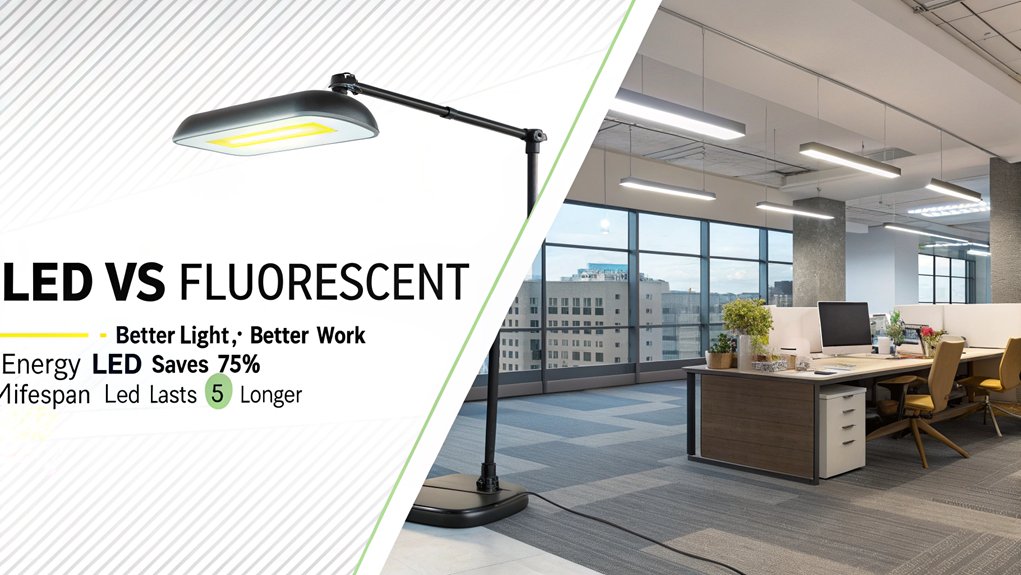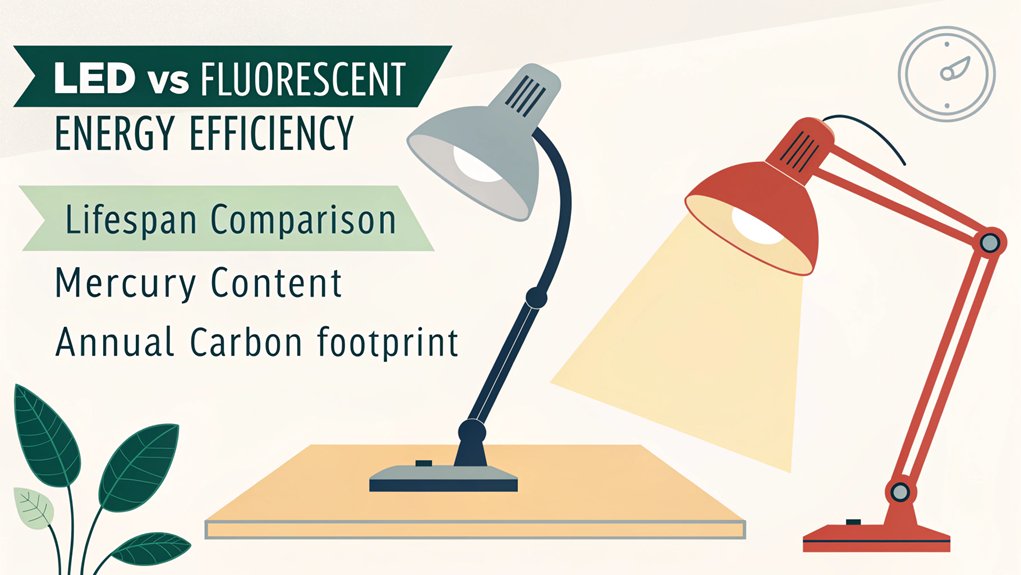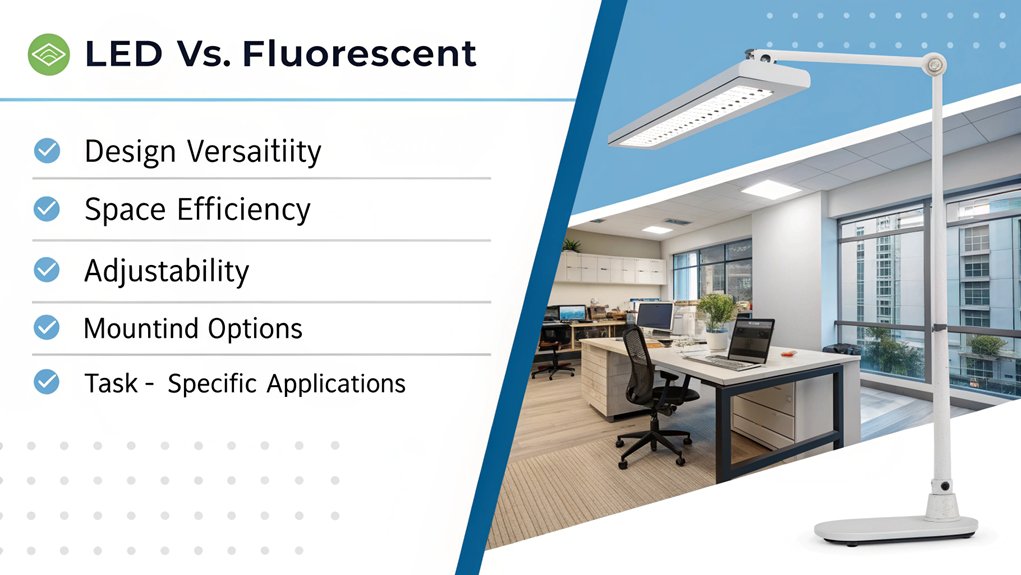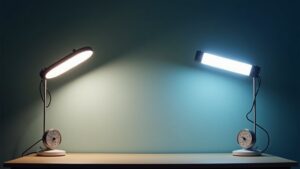When choosing desk lamps for your office, you’ll want to reflect on the differences between LED vs fluorescent desk lamps. LEDs stand out with their energy efficiency and longer lifespan, which can translate to significant cost savings. Fluorescent lamps, while still common, often fall short regarding light quality and environmental impact. Understanding these distinctions is essential for optimizing your workspace. So, what factors should you prioritize in your decision-making process?
Key Takeaways
- LEDs consume up to 75% less energy than fluorescents, resulting in lower utility costs and increased long-term savings.
- LED desk lamps provide flicker-free lighting and superior color accuracy, enhancing visual comfort and productivity.
- Fluorescent desk lamps contain hazardous mercury, posing environmental and disposal risks, while LEDs are mercury-free.
- LEDs have a lifespan of around 50,000 hours, reducing the need for frequent replacements compared to fluorescents.
- LED designs offer greater versatility and aesthetics, with options for dimming and a wide color spectrum to suit various office needs.
Energy Efficiency and Cost Savings of LED vs Fluorescent Desk Lamps
When you compare LED and fluorescent desk lamps, energy efficiency and cost savings stand out as significant advantages for LEDs.
LEDs consume up to 75% less power than fluorescents, drastically reducing your electricity usage and impacting your energy bills positively. This remarkable reduction in power consumption not only lowers utility costs but also translates to fewer LED replacements required. Additionally, the long lifespan of LED lights reduces the frequency of replacements needed, leading to further cost savings over time.
Although the initial investment may be higher, the long-term savings are substantial, making LEDs cost-effective. With less frequent maintenance required, you’ll also minimize downtime and associated labor costs.
These advantages foster an eco-friendly workspace, as reduced energy use contributes to a smaller carbon footprint. Ultimately, choosing LEDs enhances both your financial and environmental sustainability in office lighting.
Light Quality and Performance

While selecting desk lamps, understanding the differences in light quality and performance between LED and fluorescent options is vital.
| Feature | LED | Fluorescent |
|---|---|---|
| Light Directionality | Directional, focused | Omni-directional |
| Color Accuracy | CRI 70 to 95+ | CRI 60 to 90 |
| Start Time | Instant illumination | Delayed start time |
| Flicker Stability | No flicker, stable | Potential flicker |
LEDs deliver superior light directionality, enhancing task-focused lighting. Their higher color accuracy helps you perceive details accurately, important for design work. Unlike fluorescent lamps, which may flicker and waste light, LEDs provide immediate and stable illumination, creating an ideal workspace. Additionally, LEDs boast a significantly longer lifespan compared to their fluorescent counterparts, reducing the frequency of replacements and maintenance efforts. Adopting LED technology elevates your office’s aesthetic and functional dimensions, catering to innovative needs. Moreover, choosing LEDs contributes to lower energy consumption for long-term savings and sustainability.
Environmental Impact of Lighting Options

As you evaluate the environmental impact of lighting options, it’s essential to recognize how LED and fluorescent technologies differ fundamentally.
LEDs not only use up to 75% less energy compared to fluorescents but also provide significant sustainability practices and streamline waste management.
Consider the following:
- Carbon Footprint: LEDs reduce carbon emissions due to lower energy consumption.
- Hazardous Materials: Unlike fluorescents, LEDs are mercury-free, minimizing environmental risks during disposal.
- Lifespan: Longer-lasting LEDs generate less waste, leading to fewer replacements; this remarkable life span of LEDs also lessens the need for frequent manufacturing of new fixtures. Additionally, LEDs are up to 44% more efficient than 4-foot fluorescent tubes, further contributing to energy savings.
- Resource Efficiency: LED production requires fewer raw materials, supporting resource conservation.
Design Flexibility and Application

Design flexibility and application are essential considerations when choosing desk lamps for various work environments, especially in today’s diverse office setups.
LED desk lamps excel in aesthetic appeal and workspace adaptability, available in countless shapes and sizes to seamlessly fit your office layout. Their dimming capabilities and broad color spectrum allow you to customize lighting for maximum ambiance. With a lifespan of around 50,000 hours, LEDs ensure fewer replacements and reduced maintenance, making them a practical choice for busy office settings. Focused light outputs enhance task-oriented activities, while their high lumen efficiency guarantees energy savings. Unlike fluorescents, LEDs provide instant illumination without flicker or noise, promoting a comfortable working atmosphere. Additionally, the long lifecycle of LED lamps contributes to fewer environmental impacts compared to traditional lighting sources.
The sleek designs of LED fixtures enhance modern office aesthetics, making them a suitable choice for innovative environments where both functionality and visual appeal matter.
Health and Safety Considerations

Selecting the right desk lamp goes beyond aesthetics and functionality; health and safety factors play an essential role in ensuring a productive workspace. Here are key points to take into account:
- Mercury Exposure: Fluorescent lamps contain hazardous mercury, posing risks if disposed of improperly.
- Eye Health: Prolonged use of fluorescent lights above 4000K can strain your eyes and disrupt sleep due to flicker and spectral properties. Additionally, LED lights provide superior illumination without flickering, which is beneficial for maintaining eye comfort. Moreover, high colour temperature light emits blue light, inhibiting melatonin production and negatively affecting sleep quality.
- Heat Emission: LEDs operate at cooler temperatures, minimizing burn risks and improving safety.
- Visual Comfort: Unlike fluorescent tubes, LEDs eliminate flicker and buzzing, enhancing comfort and focus for sensitive individuals.
Ultimately, choosing LED lamps reduces health risks while promoting a safer and more efficient work environment.
Frequently Asked Questions
How Do LED Desk Lamps Affect Productivity in the Workplace?
LED desk lamps enhance workplace productivity by reducing eye strain and providing ideal LED brightness, which improves focus and cognitive function. Their flicker-free illumination and natural light mimicry promote better mental well-being, leading to increased efficiency.
What Are the Best Brands for LED Desk Lamps?
For top rated LED desk lamps, consider brands like BenQ and Dyson for premium features, while IKEA offers budget options with versatility. Prioritize energy efficiency, adjustability, and design to enhance your workspace’s innovation and functionality.
Can LED Desk Lamps Be Repaired if They Break?
Yes, you can repair LED desk lamps if they break. Their repairability enhances lamp lifespan, allowing you to fix faulty components easily, reducing waste and supporting sustainable practices while maintaining ideal lighting performance in your workspace.
Are There Any Rebates for Switching to LED Desk Lamps?
Yes, many energy savings rebate programs exist for switching to LED desk lamps. Utility companies and government agencies often provide incentives to offset installation costs, making it easier for you to adopt innovative, energy-efficient lighting solutions.
How Do Color Temperatures Impact the Mood in an Office?
Color temperatures greatly impact mood through color psychology. Warm lighting fosters relaxation and social interaction, while cool lighting enhances alertness and productivity. Understanding these lighting effects is essential for creating innovative, effective office environments.
Conclusion
In a world where every watt counts, switching to LED desk lamps isn’t just smart—it’s revolutionary! You’re not only slashing your energy bills but also embracing a future brimming with vibrant, flicker-free light that keeps your eyes happier than ever. Plus, by choosing LEDs, you’re championing environmental sustainability while elevating your office’s aesthetic. So, why settle for the past? Make the leap to LEDs and watch your workspace transform into a beacon of efficiency and brilliance!

I am a retired software engineer with experience in a multitude of areas including managing AWS and VMWare development environments. I bought a relative a mini-PC a year ago and have become passionate about the technology and its potential to change how we deploy software.

